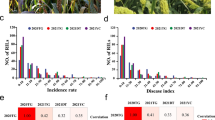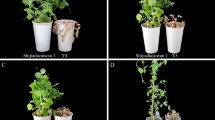Abstract
Anthracnose, caused by Colletotrichum lentis, is one of the most damaging diseases of lentil (L. culinaris) in western Canada. Lens ervoides accession IG 72815 exhibits high levels of resistance to the pathogenic races 0 and 1. The objective of this study was to identify quantitative trait loci (QTL) associated with anthracnose resistance in lentil using a recombinant inbred line (RIL) population from the interspecific cross between IG 72815 and the susceptible cultivar Eston. A total of 168 RILs were genotyped and evaluated for anthracnose race 0 and race 1 reaction in the growth chamber and polyhouse. QTL analysis identified major resistance loci on chromosomes 3 and 7 for both races, accounting for 20.1–31.2% and 8.3–18.4%, respectively, of the total phenotypic variation for anthracnose resistance. Multiple classes of putative defense-related genes are located within both loci. Further characterization of these regions will facilitate the introgression of anthracnose resistance from Lens ervoides into elite lentil cultivars via marker-assisted selection.



Similar content being viewed by others
Data availability
The raw genotypic data supporting this study are available at https:// knowpulse.usask.ca/ Geneticmap/2691115 upon request from the authors.
References
Almagro L, Ros LG, Belchi-Navarro S, Bru R, Barceló AR, Pedreno MA (2009) Class III peroxidases in plant defence reactions. J Exp Bot 60:377–390
Andersen EJ, Ali S, Byamukama E, Yen Y, Nepal MP (2018) Disease resistance mechanisms in plants. Genes (Basel) 339:1–30
Banniza S, Warale R, Menat J, Cohen-Skali A, Armstrong-Cho C, Bhadauria V (2018) The long path to understanding the host-pathogen interactions of Colletotrichum lentis on lentil. Can J Plant Pathol 40(2):199–209
Barilli E, Moral J, Aznar-Fernández T, Rubiales D (2020) Resistance to anthracnose (Colletotrichum lentis, Race 0) in Lens spp. germplasm. Agronomy 10:1799
Bhadauria V, Ramsay L, Bett KE, Banniza S (2017) QTL map** reveals genetic determinants of fungal disease resistance in the wild lentil species Lens ervoides. Sci Rep-UK 7:3231
Bolger AM, Lohse M, Usadel B (2014) Trimmomatic: a flexible trimmer for Illumina sequence data. Bioinformatics 30:2114–2120
Broman KW, Wu H, Sen S, Churchill GA (2003) R/qtl: QTL map** in experimental crosses. Bioinformatics 19(7):889–890
Buchwaldt L, Anderson KL, Morrall RAA, Gossen BD, Bernier CC (2004) Identification of lentil germplasm resistant to Colletotrichum truncatum and characterization of two pathogen races. Phytopathology 94:236–243
Buchwaldt L, Dzananovic E, Durkin J (2018) Lentil anthracnose: epidemiology, fungicide decision support system, resistance and pathogen races. Can J Plant Pathol 40(2):189–198
Buchwaldt L, Shaikh R, Adam J, Tullu A, Slinkard A (2013) Recessive and dominant genes confer resistance to Colletotrichum truncatum in cultivated lentil. Can J Plant Pathol 35:222–231
Burt AJ, William HM, Perry G, Khanal R, Pauls KP, Kelly JD, Navabi A (2015) Candidate gene identification with SNP marker-based fine map** of anthracnose resistance gene Co-4 in common bean. PLoS ONE 10(10):e0139450
Chen L (2018) Assessing impacts of crop-wild introgression in lentil using interspecific lens species recombinant inbred line populations. Ph.D. Dissertation, University of Saskatchewan
Chongo G, Bernier CC, Buchwaldt L (1999) Control of anthracnose in lentil using partial resistance and fungicide applications. Can J Plant Pathol 21:16–22
Coyne CJ, Kumar S, von Wettberg EJB, Marques E, Berger JD, Redden RJ, Ellis THN, Brus J, Zablatzka L, Smykal P (2020) Potential and limits of exploitation of crop wild relatives for pea, lentil, and chickpea improvement. Legume Sci 2(2):e36
Cubero JI, Pérez de la Vega M, Fratini R (2009) Origin, phylogeny, domestication and spread. In: Erskine W, Muehlbauer FJ, Sarker A, Sharma B (eds) The lentil: botany, production and uses. CAB International, Wallingford, pp 13–33
Damm U, O’Connell RJ, Groenewald JZ, Crous PW (2014) The Colletotrichum destructivum species complex hemibiotrophic pathogens of forage and field crops. Stud Mycol 79:49–84
Danecek P, Auton A, Abecasis G, Albers CA, Banks E, DePristo MA, Handsaker RE, Lunter G, Marth GT, Sherry ST, McVean G, Durbin R (2011) The variant call format and VCFtools. Bioinformatics 27(15):2156–2158
Delteil A, Gobbato E, Cayrol B, Estevan J, Michel-Romiti C, Dievart A, Kroj T, Morel JB (2016) Several wall-associated kinases participate positively and negatively in basal defense against rice blast fungus. BMC Plant Biol 16:17
Dempewolf H, Baute G, Anderson J, Kilian B, Smith C, Guarino L (2017) Past and future use of wild relatives in crop breeding. Crop Sci 57:1070–1082
Dodds P, Rathjen J (2010) Plant immunity: towards an integrated view of plant-pathogen interactions. Nat Rev Genet 11:539–548
Douchkov D, Lueck S, Hensel G, Kumlehn J, Rajaraman J, Johrde A, Doblin MS, Beahan CT, Kopischke M, Fuchs R, Lipka V, Niks RE, Bulone V, Chowdhury J, Little A, Burton RA, Bacic A, Fincher GB, Schweize P (2016) The barley (Hordeum vulgare) cellulose synthase-like D2 gene (HvCslD2) mediates penetration resistance to host-adapted and nonhost isolates of the powdery mildew fungus. New Phytol 212:421–433
FAOSTAT (2017) Food and agriculture organization of the United Nations (FAO) Statistical Division. http://www.fao.org/faostat/en/#data/QC
Felderhoff TJ, McIntyre LM, Saballos A, Vermerris W (2016) Using genoty** by sequencing to map two novel anthracnose resistance loci in Sorghum bicolor. G3 6(7):1935–1946
Fiala JV, Tullu A, Banniza S, Séguin-Swartz G, Vandenberg A (2009) Interspecies transfer of resistance to anthracnose in lentil (Lens culinaris Medic.). Crop Sci 49:825–830
Garcia-Andrade J, Ramirez V, Lopez A, Vera P (2013) Mediated plastid RNA editing in plant immunity. PLoS Pathog 9:e1003713
Gela TS, Banniza S, Vandenberg A (2020) Lack of effective resistance to the virulent race of Colletotrichum lentis in Lens culinaris Medikus subsp. culinaris. Plant Gen Res Char Util 18(2):81–87
Haley CS, Knott SA (1992) A simple regression method for map** quantitative trait loci in line crosses using flanking markers. Heredity 69(4):315–324
Kissinger G (2016) Pulse crops and sustainability: a framework to evaluate multiple benefits. http://www.fao.org/pulses
Ladizinsky G, Braun D, Goshen D, Muehlbauer F (1984) The biological species of the genus Lens L. Bot Gaz 145:253–261
Langmead B, Salzberg SL (2012) Fast gapped-read alignment with Bowtie 2. Nat Methods 9:357–359
Li H, Handsaker B, Wysoker A, Fennell T, Ruan J, Homer H, Marth G, Abecasis G, Durbin R (2009) The sequence alignment/map format and SAMtools. Bioinformatics 25:2078–2079
Manichaikul A, Moon JY, Sen S, Yandell BS, Broman KW (2009) A model selection approach for the identification of quantitative trait loci in experimental crosses, allowing epistasis. Genetics 181:1077–1086
Martin GB, Bogdanove AJ, Sessa G (2003) Understanding the functions of plant disease resistance proteins. Annu Rev Plant Biol 54:23–61
Morrall RAA, Pedersen EA (1990) Discovery of lentil anthracnose in Saskatchewan in 1990. Can Plant Dis Surv 71:105–106
Morrall RAA (1988) A new disease of lentil induced by Colletotrichum truncatum in Manitoba. Plant Dis 72:994
Murube E, Campa A, Ferreira JJ (2019) Integrating genetic and physical positions of the anthracnose resistance genes described in bean chromosomes Pv01 and Pv04. PLoS ONE 14(2):e0212298
Ogutcen E, Ramsay L, von Wettberg EB, Bett KE (2018) Capturing variation in Lens (Fabaceae): development and utility of an exome capture array for lentil. Appl Plant Sci 6:e01165
Patil NY, Klein RR, Williams CL, Collins SD, Knoll JE, Burrell AM, Anderson WF, Rooney WL, Klein PE (2017) Quantitative trait loci associated with anthracnose resistance in sorghum. Crop Sci 57:877–890
Podder R, Banniza S, Vandenberg A (2013) Screening of wild and cultivated lentil germplasm for resistance to Stemphylium blight. Plant Genet Res 11:26–35
Poland JA, Brown PJ, Sorrells ME, Jannink JL (2012) Development of high-density genetic maps for barley and wheat using a novel two-enzyme genoty**-by-sequencing approach. PLoS ONE 7:e32253
Raghuvanshi RS, Singh DP (2009) Food preparation and use. In: Erskine W, Muehlbauer FJ, Sarker A, Sharma B (eds) The lentil: botany, production and uses. CABI Cambridge, Cambridge, MA, pp 408–424
Ramsay L, Koh C, Konkin D, Cook D, Penmetsa V, Dongying G, Coyne C, Humann J, Kaur S, Dolezel J, Bett KE (2019) Lens culinaris CDC Redberry genome assembly v2.0. Retrieved from https://knowpulse.usask.ca/genome-assembly/Lcu.2RBY
Rebai A (1997) Comparison of methods of regression interval map** in QTL analysis with non-normal traits. Genet Res 65:68–74
Schmitz-Linneweber C, Small I (2008) Pentatricopeptide repeat proteins: a socket set for organelle gene expression. Trends Plant Sci 13:663–670
Sekhwal MK, Li P, Lam I, Wang X, Cloutier S, You FM (2015) Disease resistance gene analogs (RGAs) in plants. Int J Mol Sci 16:19248–19290
Shi H, Wang X, Ye T, Chen F, Deng J, Yang P, Zhang Y, Chan Z (2014) The Cysteine2/Histidine2-Type transcription factor ZINC FINGER OF ARABIDOPSISTHALIANA6 modulates biotic and abiotic stress responses by activating salicylic acid-related genes and C-REPEAT-BINDING FACTOR genes in Arabidopsis. Plant Physiol 165:1367–1379
Slinkard AE (1981) Cultivar description: Eston lentil. Can J Plant Sci 61:733–734
Stange M, Utz HF, Schrag TA, Melchinger AE, Würschum T (2013) High-density genoty**: an overkill for QTL map**? Lessons learned from a case study in maize and simulations. Theor Appl Genet 126:2563–2574
Tanksley S, McCouch S (1997) Seed banks and molecular maps: unlocking genetic potential from the wild. Science 277:1063–1066
Taylor J, Butler D (2017) R package ASMap: efficient genetic linkage map construction and diagnosis. J Stat Softw 79(6):1–29
Torii KU (2004) Leucine-rich repeat receptor kinases in plants: structure, function, and signal transduction pathways. Int Rev Cytol 234:1–46
Tullu A, Banniza S, Tar’an B, Warkentin T, Vandenberg A (2010) Sources of resistance to ascochyta blight in wild species of lentil (Lens culinaris Medik.). Genet Resour Crop Evol 57:1053–1063
Tullu A, Bett K, Banniza S, Vail S, Vandenberg A (2013) Widening the genetic base of cultivated lentil through hybridization of Lens culinaris “Eston” and L. ervoides accession IG 72815. Can J Plant Sci 93:1037–1047
Tullu A, Buchwaldt L, Lulsdorf M, Banniza S, Barlow B, Slinkard AE, Sarker A, Tar’an B, Warkentin T, Vandenberg A (2006) Sources of resistance to anthracnose (Colletotrichum truncatum) in wild Lens species. Genet Res Crop Evol 53:111–119
Tullu A, Buchwaldt L, Warkentin T, Tar’an B, Vandenberg A (2003) Genetics of resistance to anthracnose and identification of AFLP and RAPD markers linked to the resistance gene in PI 320937 germplasm of lentil (Lens culinaris Medikus). Theor Appl Genet 106:428–234
Van Oss H, Aron Y, Ladizinsky G (1997) Chloroplast DNA variation and evolution in the genus Lens Mill. Theor Appl Genet 94:452–457
Wong MML, Gujaria-Verma N, Ramsay L, Yuan HY, Caron C, Diapari M, Vandenberg A, Bett KE (2015) Classification and characterization of species within the genus Lens using genoty**-by-sequencing (GBS). PLoS ONE 10(3):e0122025
Zeng ZB (1994) Precision map** of quantitative trait loci. Genetics 136(4):1457–1468
Zhou J, Loh YT, Bressan RA, Martin GB (1995) The tomato gene Pti1 encodes a serine/threonine kinase that is phosphorylated by Pto and is involved in the hypersensitive response. Cell 83:925–935
Acknowledgements
The authors gratefully acknowledge funding from the Natural Sciences and Engineering Research Council of Canada (NSERC) Industrial Research Chair Program, the Saskatchewan Pulse Growers, and the University of Saskatchewan. We are also thankful for the technical assistance of the bioinformatics, molecular and pathology lab staff of the Pulse Breeding and Genetics group at the University of Saskatchewan.
Author information
Authors and Affiliations
Contributions
TSG generated phenotypic data, preformed data analyses and wrote the manuscript; LC performed the genoty** of the map** population; CC carried out SNP calling; CSK constructed the genetic map, AV and KEB conceived the experiment and critically reviewed the manuscript. All authors read and approved the final version.
Corresponding author
Ethics declarations
Conflict of interest
The authors declare that they have no conflict of interest.
Additional information
Publisher's Note
Springer Nature remains neutral with regard to jurisdictional claims in published maps and institutional affiliations.
Supplementary Information
Below is the link to the electronic supplementary material.
Rights and permissions
About this article
Cite this article
Gela, T.S., Koh, C.S., Caron, C.T. et al. QTL map** of lentil anthracnose (Colletotrichum lentis) resistance from Lens ervoides accession IG 72815 in an interspecific RIL population. Euphytica 217, 70 (2021). https://doi.org/10.1007/s10681-021-02804-0
Received:
Accepted:
Published:
DOI: https://doi.org/10.1007/s10681-021-02804-0




